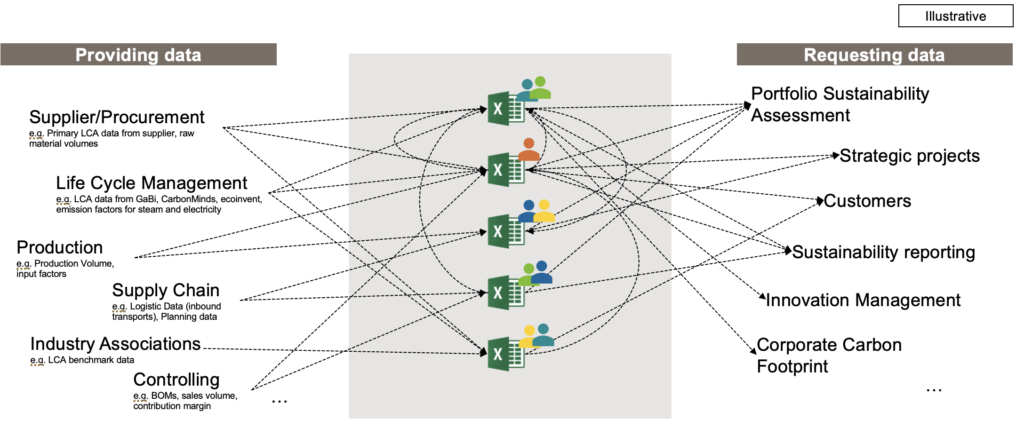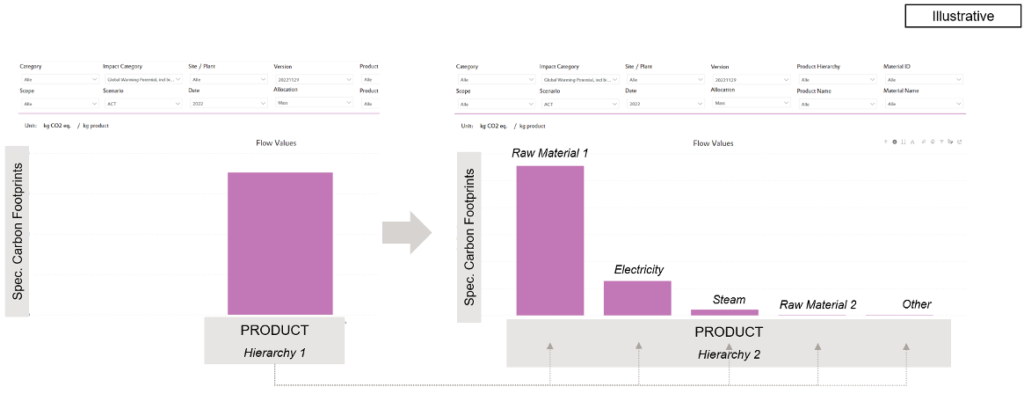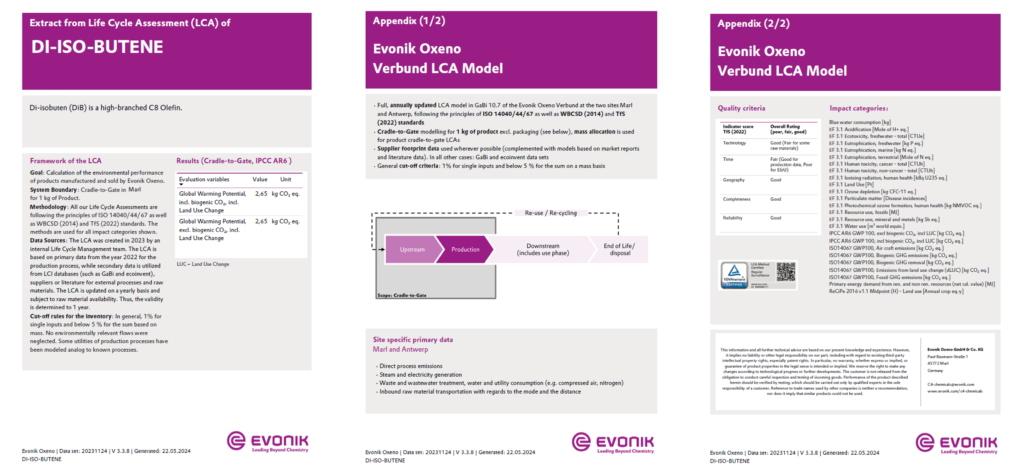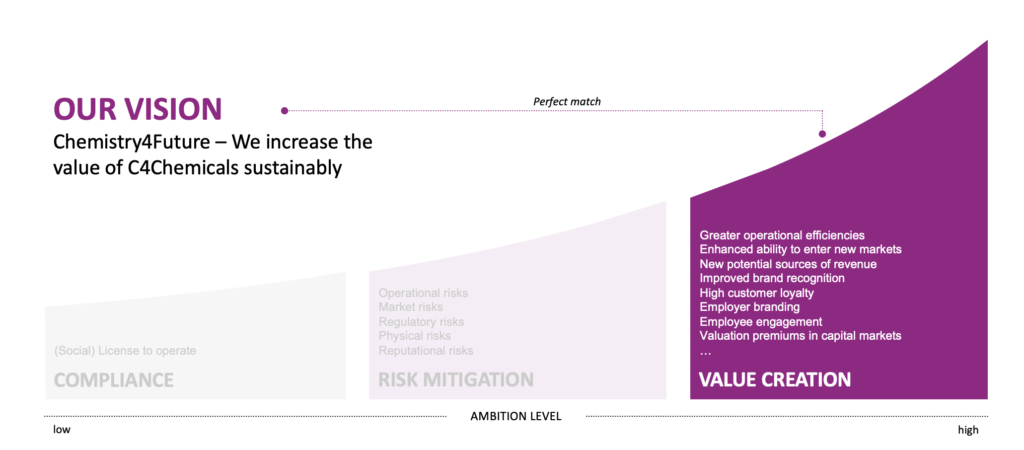SUScube – An innovative approach to sustainability data management from practice
The increasing importance of sustainability goes hand in hand with higher demand, more visibility and a more intensive exchange of sustainability data and information, both along the value chain and within a company. Previous ways of managing this data and information are inefficient, slow and error-prone. The goal for Evonik Oxeno (1) was therefore to develop an application that (a) primarily satisfies customers‘ needs for reliable and credible sustainability data while increasing the efficiency of data provision, and (b) improves the usability and presentation of sustainability data internally. In short, the ambition was to create a „single point of truth“ for sustainability data with an appealing user interface. Oxeno’s solution, a Power BI-based dashboard called „SUScube“, was developed in 2021, has been in use since then and is continuously being expanded with further functionalities. At its core, SUScube is based on an external certified Life Cycle Assessment (LCA) model of Oxeno’s production sites in Marl and Antwerp.
Business Conditions and Business Needs
The well-known economist Peter Drucker once said: „If you can‘t measure it, you can‘t manage it.“ This quote also applies to the topic of sustainability. Customers, investors, competitors, politicians and, last but not least, society are attaching more and more importance to the topic of sustainability, and this inevitably means that already today and even more in the future, business will have to provide answers to the following questions in order to remain competitive:
- What is the carbon footprint / environmental impact (2) of our products?
- What are the biggest factors influencing our product carbon footprints?
- What are the Scope 1, 2 and 3 emissions (3) ?
- Where are the biggest levers for improving our sustainability performance?
- What CO2 saving potentials can be identified in the individual production plants?
- What effect would switching to greener alternatives (raw materials, electricity, etc.) have on our carbon footprint?
- etc.
In recent years, Oxeno observed that sustainability information and data are no longer just requested, but demanded, especially from customers with the regulatory environment (e.g. Corporate Sustainability Reporting Directive, CSRD) playing an important role here (CHEManager, 2023). And the message is clear: Even if there are currently no noticeable consequences, companies that cannot or do not want to meet the requirements for an adequate provision of sustainability data, will run the risk of no longer being a preferred supplier and thus losing business in the foreseeable future. In addition to that, it can be said that end markets close to the end consumer and with highermargin products, ask more for this data and information. In particular, as the fight against climate change is one of the most pressing issues, the product carbon footprint (PCF) was and is the focus (4). This is also the reason why most of the attention in the development of the SUScube was put there, although other environmental impact categories related to water consumption, pollution, waste, etc. can also be assessed. But sustainability data management is not only playing an increasingly important role externally. Sustainability data and information are also becoming ever more important for e.g.
- the management of companies in the context of binding sustainability goals (e.g. Science-based Target Initiative (SBTi; more information is available here: https://sciencebasedtargets.org/)),
- the identification of improvement levers in production processes,
- the management and prioritization of investments and
- the targeted further development of the product portfolio towards more sustainability.
Regardless of the interest group, it is clear that it is important to set up the process of data and information provision as quickly, robustly and credibly as possible and to make communication reliable, easy to understand and transparent. Previous ways of managing this data and information – so far mostly via a wide variety of Excel files and often by different people – are inefficient, slow and error-prone (see Figure 1). With SUScube this has now been significantly simplified and improved.
SUScube: Description and functionalities
Oxeno’s solution to e.g.
- retrieve and provide sustainability data for customers and other stakeholders,
- identify potentials for improvement in the individual production plants or
- display the corresponding Scope 1 and 2 emissions aggregated in absolute numbers at site level
all in a user-friendly interface is a Power BI-based dashboard called „SUScube“. SUScube was developed in 2021 and has been in continuous use since then, with ongoing expansion to include additional functionalities. The core of SUScube is based on an externally certified Life Cycle Assessment (LCA) model of Oxeno’s sites in Marl and Antwerp (see Figure 2). Moreover, SUScube is connected to standardized production and financial data from SAP. The consistent application of data warehouse principles enables the generation of various data slices as per the requirements of customers and other stakeholders. Currently, SUSCube already offers a variety of different data (Product-specific data, Customer-oriented data, absolute values) and analysis-/evaluation options. Some of them are described in more detail in the following sections.
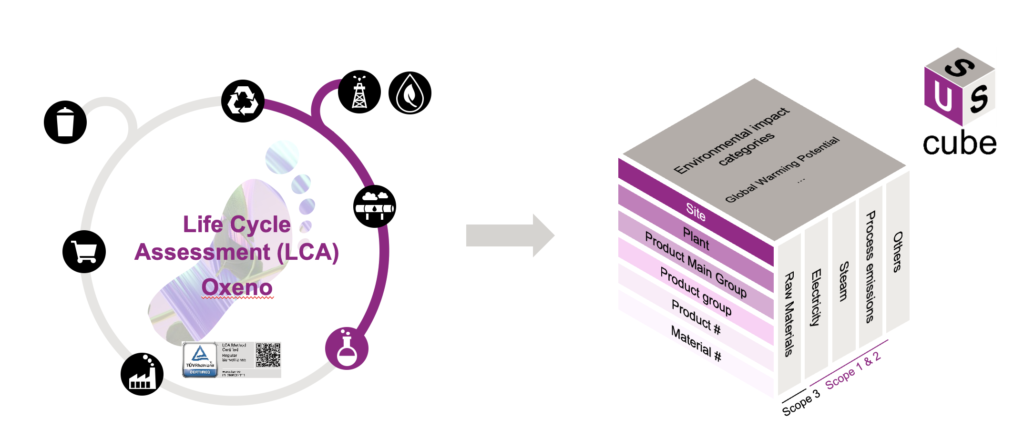
Figure 2: Oxeno holds a TüV Rheinland certification for its cradle-to-gate LCA model, which is the base for SUScube.
Drill-Through functionality
Currently, SUScube provides access to all LCA results on product level allowing to perform so-called „drill-throughs“ (see Figure 3). It is possible to fan out values step by step down to the lowest data level, e.g. to the purchased raw materials. This is always relevant if you want to know, for example, what are the main factors influencing the product carbon footprint. Another field of application is production, where a systematic evaluation of possible fields of action to further improve your Scope 1 and 2 emissions is enabled. Last but not least, for innovation this feature serves as a starting point for the targeted development of more sustainable processes and/or products.
LCA environmental impact categories
Since all LCA results are loaded into the dashboard, in addition to the carbon footprint, other environmental impact categories related to water consumption, pollution, waste, etc. as well can also be evaluated.
Scenario Analysis
SUScube also has the option to play through scenarios (see Figure 4). For example, it is possible to simulate how the product carbon footprint would change if fossil raw materials were substituted by renewable ones or the production is run by 100% green electricity. This helps, for example, to select the right raw materials in purchasing and thus supports the medium to long-term optimization of raw material and product flows from a sustainability perspective or to make well-founded decisions when purchasing energy. In addition, SUScube users are able to show their customers the sustainability potential in terms of e.g. product carbon footprint improvement that can be leveraged by switching to more sustainable product alternatives. Customers can then use this information to e.g. calculate the effect on their Scope 3 savings target, which again supports decision making.
LCA One-Pager generation
In order to ensure the most systematic and uniform customer communication possible, the SUScube also has templates for LCA results (LCA One-Pager). On an appealing user interface, Marketing Managers for instance are guided through a context menu in which the respective product, the location and – if needed – the raw material category according to ISCC-Plus (most leading certification system for bio, bio-circular and circular feedstocks and products, (ISCC, 2024)) are selected. The corresponding information and data is then automatically loaded into the template via the Power BI dashboard, which can then be saved as a PDF and sent to the customer without any further approval process (see Figure 5). From a marketing perspective this improves customer communication significantly with regard to sustainability data by proceeding faster, more reliably, more systematically and therefore more professionally. This functionality also meets the above-mentioned demand of customers regarding high quality sustainability data. Being a frontrunner here, provides the opportunity for companies to create value in terms of higher customer loyalty and the securing of market shares. Last but not least, the modular nature of the data model allows to react quickly to new or changing requirements and adapt the SUScube reports – including the LCA One-Pager – accordingly or develop new ones.
Outlook: Functionalities
SUScube is already used and will be more integrated in the annual strategic management process to derive, control and review Oxeno’s goals and the degree to which Oxeno has achieved its ambitions. SUScube serves as the single point of truth for obtaining the data needed for the analysis and projections. By combining standardized financial and production data from SAP as well as LCA data, novel KPIs (e.g. Contribution Margin [EUR]/t of emitted CO2) for managing sustainability more effectively in the future can be developed and applied. Furthermore, it is planned to use the SUScube as a database for supplier footprint data and thus make this information more easily available to other departments, who need access to this information. Last but not least, the SUScube is an important building block in the context of Oxeno’s digitalization activities towards a data-driven organization. In the next stage of expansion, it is planned to process and make available the increasing data volumes in a high-performance Spark cluster (5) , in order to be able to efficiently provide the data volumes that will increase immensely in the future.
SUScube: An innovative approach in terms of sustainability data management
SUScube is characterized by several innovative aspects, the most important of them are briefly described below, namely the LCA modelling approach, which is the basis for SUScube, the linking of a wide variety of data sources and the establishment of a versatile and scalable data model.
LCA modelling approach
In 2021 Oxeno decided to renew its existing LCA, which was already conducted in 2012 for the first time. However, instead of just updating the model, it was determined to set up the LCA model from scratch in order to be able to meet today‘s and tomorrow‘s needs of providing LCA data to customers and other stakeholders. The following section provides a short overview of the most significant improvements compared to the 2012 LCA model:
- To ensure seamless integration of the LCA model into the existing structures, the Bill of Materials (BOMs) from SAP were utilized as the structural foundation for the development of the LCA model. This guarantees that all products present in SAP can be easily linked to the LCA model and vice versa.
- Oxeno has also come up with a concept for how to import mass and energy balance data into the LCA model as automatically as possible in order to avoid the manual feeding of data, which is very timeconsuming and error-prone, especially against the background of the large amounts of data.
- Finally, this new kind of LCA model also considered the aspect of conducting scenario analysis by applying global parameters in the LCA model for easily changing parameters (e.g. electricity mix, raw material mix, etc.). This makes it very easy to evaluate changes in the product carbon footprint or other environmental impacts when switching from e.g. a fossil to a bio-based feedstock. It is crucial to highlight this aspect as it facilitates communication with customers by enabling to accurately quantify potential CO2 reductions. This, in turn, assists customers in understanding the impact of changing Oxeno’s raw material base on their sustainability targets.
Linking different data sources
A data model was developed that links relevant standardized data (e.g. from LCA, SAP and Production) and makes it available in a so-called OLAP cube (OLAP = Online Analytic Processing). This innovative approach overcomes the drawbacks of distributing data across all over the organization. The data is no longer available in different files, and in different server folders which have to be brought together in a time-consuming and, not least, error-prone process. Rather, an automated transformation workflow ensures that the data is automatically transferred to the data model. Once in the data model, users can carry out evaluations according to all dimensions that are spanned in the model and thus implement a wide variety of use cases very flexibly. The versioning of the data model ensures traceability („single point of truth“) and uniqueness of the data at all times.
Building a scalable data model
Due to the amount of data, the data sources described above can no longer be entered into an Excel spreadsheet (Excel does not have enough rows to cover all data and it is foreseeable that further dimensions will continue to enlarge the model in the near future). Therefore, a business intelligence tool was chosen that on the one hand has a wide distribution in the organization and on the other hand is performant enough to evaluate the amount of data with acceptable latency times. So Power BI was the tool of choice, which can be made available to selected and authorized people in the organization by publishing it as a service. Due to the projected increase in the size of the data model, a transfer of the transformation workflow into a highperformance system based on a Spark cluster was started. This means that there is no anticipated upper limit due to the amount of data to be processed and the scalability of the approach is ensured.
Transferability of the approach
To answer the question of transferability, it is worth taking a brief look at the sources on which the SUScube is based and the means by which the data is transformed and made available. The LCA model, which is the data basis for the SUScube, draws on the following sources for emission factors: Direct emissions reports, site-specific emission factors for electricity, steam and other utilities, primary data for raw materials (if available, otherwise secondary database values are used). The mass and energy balances come from the respective production information management system (PIMS), transport data comes from the logistics department, and the BOMs form the structure of the LCA model. The actual LCA model was created using the software Sphera™ LCA for Experts 10.8 software, formerly known as “GaBi”. Due to a lack of interface in LCA for Experts, data is exported via the csv file format. These files are then processed and loaded into Power BI. In sum, it can be said that the SUScube has all the prerequisites to be implemented by other organizations in a similar way (knowing full well that each organization has its peculiarities and it is likely to adapt the concept at one point or another), as it relies on inputs / tools / competencies which should be widely available . At this point, it should not go unmentioned that the SUScube was purely developed and implemented in-house and without the involvement of external IT consultants in a small and agile project team. This provides the opportunity to continuously develop the SUScube easily and quickly without incurring external costs.
Benefits of SUScube
Meeting customer’s demands
Just like suppliers, Oxeno’s customers are also pursuing ambitious sustainability goals, with the topic of greenhouse gas reduction clearly dominating here. With regard to the value chains, the proportion of CO2 footprint from raw materials increases more and more the closer you get to the end consumer. This is why, in addition to Scope 1 and Scope 2 targets, which essentially affect the respective company‘s own scope of action and are thus largely controllable internally, Oxeno’s downstream value chain partners are also increasingly setting themselves scope 3 targets. These are essentially aimed at reducing the CO2 footprint coming from raw materials. In order for customers to manage their Scope 3 goals effectively and efficiently, they depend on the following aspects:
- Data Availability: It may sound trivial, but in order to manage their Scope 3 goals, customers need information on the product carbon footprints of their purchased goods. In the best case, this information is based to a large extent on primary data. If you don‘t get any information about the PCF values of your suppliers, you have no choice but to calculate with assumptions and estimates, which leads us directly to the next point – reliability.
- Reliability: Customers need reliable and high-quality data. In 2021, Oxeno therefore completely recreated its Verbund LCA (see above) with the aim of serving current and future customer requirements in the best possible way. A building block in this LCA strategy was to have the LCA model externally certified to ensure that the LCA model complies with applicable ISO standards and chemical sector-specific rules. In order to always be able to provide customers with the latest LCA values, it was also decided to carry out annual updates of the LCA model and to perform external certification at regular intervals. This ensures that methodological developments, process technology innovations as well as updated primary data are always taken into account in the LCA model, leading to a very high level of reliability and trustworthiness for customers.
- Transparency: The LCA model is used, for example, to calculate the PCF values for Oxeno’s products, but is only suitable to a limited extent in the context of customer communication. This requires a different vehicle, which has been created with the so-called „LCA One-Pager“. The LCA One-Pager is a document that can be generated from the SUScube and provides all LCArelevant information (System boundaries, Functional unit, Environmental impact category methodology, TfS Quality indicators, etc.) in an appealing and clear layout for customers (see Figure 5). The LCA One-Pager also features a QR code that refers to the external certificate of Oxeno’s LCA model (see paragraph “SUScube: Description and functionalities”)
- Speed: Among other things, you distinguish yourself with a very good customer service if you provide customers with comprehensive support, advise them, value them, anticipate their needs and respond quickly to their inquiries. In particular, the last two points are addressed and made possible by SUScube. While it is not yet common practice to have LCA data accessible for the entire product range, Oxeno have positioned itself as pioneers in this area. Furthermore, internal processes have been optimized in such a way that the desired LCA data can be generated easily and quickly by the respective marketing and sales managers via the LCA One-Pagers mentioned above and shared with customers within a couple of minutes.
In summary, with the SUScube and the underlying LCA model, Oxeno positions itself as an innovative supplier, who supports their customers in their journey to reduce scope 3 emissions with credible data by applying efficient internal processes. Furthermore SUScube enables the marketing and sales team to provide LCA data to partners promptly in a standardized, comprehensive and comparable manner. What should not be forgotten in conclusion is that the LCA One-Pagers are a good starting point for more intensive follow-up discussions and thus open the door for potentially further business (e.g. when it comes to product alternatives with lower PCF).
Contribute to improving competitive position
While sustainability was a more or less voluntary topic ten years ago, it has now developed into a firmly established topic that, if not addressed, entails a financial risk that is not to be underestimated in the future (e.g. by not meeting regulatory requirements, poor financing conditions on the capital markets, reputational risk (Cox et al., 2022)). Likewise, the topic of sustainability offers companies, if they approach it effectively and efficiently, opportunities to differentiate themselves in the market and thus be (more) economically successful. SUScube addresses both: Value creation and Cost savings.
Value Creation
For Oxeno, sustainability is more than just “Compliance” and “Risk mitigation” (see Figure 6). It is about differentiation and the generation of competitive advantages which leads to value creation (Berns et al., 2019). Against this background, SUScube is one important strategic vehicle, as Oxeno is able to
- respond quickly and with high quality to the needs of their customers and
- provide high quality sustainability data for 100 % of their product portfolio.
This increases Oxeno’s reputation as a leading company in terms of sustainability data management. Together with other sustainability activities, Oxeno is thus laying the foundation for remaining the preferred supplier in the future and accompanying customers on their sustainability journey. With products from the eCO series and RFP series (see Figure 7), Oxeno already offers alternatives to fossil products and is aiming to sell them on a larger scale and accelerate the transition towards more sustainability.
Cost savings
Oxeno’s plans are also to use the SUScube to control and monitor Scope 1 & 2 emissions in the future. The transparency of carbon footprint data enables Oxeno to enhance the efficiency of reducing Scope 1 and 2 emissions, which, against the backdrop of rising costs such as CO2 certification expenses from the Emission Trading System (EU-ETS), will help to identify further cost saving potentials in the future. In addition, the SUScube offers numerous internal advantages: By creating a single point of truth for sustainability data, there is exactly one central location that holds sustainability data and from where likewise, different use cases can be operated. Be it in the context of an investment calculation that addresses the topic of CO2 savings, in the context of the strategy dialogue with the board (CO2 development over time from an organizational point of view) or in the provision of product carbon footprint (PCF) data to customers. In all cases, the SUScube helps to save time and thus costs, by e.g. eliminating the need to go through numerous different Excel files to gather all the relevant data. As a result, operational work is reduced and an organization-wide standardized communication is ensured. The following points are particularly noteworthy in this context. For the marketing teams, for example, lengthy coordination processes are now no longer necessary. The abovementioned LCA One-pagers are generated from the SUScube and since the data on the LCA One-Pager is already approved, it can then be sent directly to the customer. Against the sake of more efficient and less complex processes as well as the intuitive front-end, the SUScube was very quickly adopted by the various users from marketing, production, purchasing and strategy and there were no greater challenges in the roll-out and implementation phase. In the end, no major effort had to be put into training; again a point where costs have been saved. In order to develop the SUScube in this way, a wide variety of skills was needed, which were found in-house and thus without incurring external costs. A lot of improvements have already been implemented thanks to the great feedback of users and customers. This is where the advantage of having developed the SUScube itself becomes particularly apparent – changes, customization and updates can be implemented very quickly and without additional external costs. One last point that should be emphasized in this chapter is that the development of the SUScube now also generates a much better understanding of Oxeno’s data landscape and the people responsible in each case and can now work better on further optimization and harmonization. In summary, with SUScube an application has been developed and implemented that creates value for a wide range of stakeholders:
- With SUScube, business needs of partners in terms of efficiency, reliability and credibility when it comes to sustainability data exchange are addressed
- The user-friendly interface in combination with preapproved data allows fast and intuitive extraction and distribution of requested information. The inefficient, slow and error-prone practice of using various Excel files by different people is eliminated.
- Oxeno and its partners can trust the data as the single point of truth approach reduces possibility of errors for sustainability data and increases its reliability
- SUScube supports the exchange process with customers and other partners and promotes dialogue in the context of sustainability along the C4 value chain
Conclusion
Sustainability is becoming increasingly important for customers, investors, competitors, politicians, and society, and businesses need to provide answers to sustainabilityrelated questions to remain competitive. Providing sustainability data and information as quickly, robustly, and credibly as possible and making communication reliable, easy to understand, and transparent is essential. SUScube, a Power BI-based dashboard, offers a solution. SUScube is to be seen as a strategic vehicle for Oxeno and is based on a modular and scalable data model, links different data sources and has all the prerequisites to be implemented by other businesses in a similar way. Or to put it in other words: Sustainability is about fulfilling customer demands, by operating responsibly, by taking care of our employees and by ensuring to operate within our planetary boundaries. In order to reach this target, the SUScube is an important piece of the puzzle, as it helps compiling and analyzing the various data in an appealing and structured way. In response to the question of the added value provided by SUScube, the following points can be summarized as key takeaways:
- Meeting customer demands: With SUScube, businesses can provide their customers with high-quality sustainability data in a standardized, comprehensive, and comparable manner. This helps to improve customer communication and build trust, leading to increased customer loyalty and a better reputation.
- Simplifying processes: SUScube simplifies the process of data and information provision by providing a userfriendly interface and automating the transformation workflow. This eliminates the need for lengthy coordination processes and the use of various Excel files, saving time, reducing the risk of errors and ultimately generating cost savings.
- Supporting decision-making: SUScube allows businesses to evaluate different scenarios and simulate the impact of switching to more sustainable alternatives, helping them make well-founded decisions when purchasing energy or selecting the right raw materials in purchasing.
- Facilitating communication: SUScube creates a single point of truth for sustainability data, which facilitates communication with different stakeholders within as well as outside of the organization. This helps for example to optimize internal processes and improve cross-functional collaboration (e.g. in terms of investment projects).
That being said, SUScube and the externally certified LCA model behind it are an important building block in the context of businesses‘ digitalization activities towards a datadriven organization and in positioning Oxeno as a proactive company in terms of sustainability. In this context, it should be emphasized once again that 100% LCA data coverage is not yet standard. The same applies to the way in which data is provided in the form of the LCA One Pager. This is also being recognized by customers and their feedback, which has been consistently positive so far. For the future the plan is to develop SUScube as the central platform for the management of sustainability data. Ideas for further development are numerous, such as the integration of primary data from suppliers as well as the further development of the transformation workflow into a high-performance system based on a Spark cluster that ensures the scalability of the approach. If this paper has shown one thing, it is that it is essential to have a functioning sustainability data system in perspective, because: In the traditional business world, we are used to preparing and reading quarterly financial statements, annual financial statements and KPIs. In the future, we will handle sustainability data just as naturally. SUScube is one solution to embark on this journey and to be able, to serve future requirements in the best possible way and thus generate competitive advantages.
References
Abbass, K., Qasim, M. Z., Song, H., Murshed, M., Mahmood, H., Younis, I. (2022): A review of the global climate change impacts, adaption, and suitable mitigation measures, Environmental Science and Pollution research, 29, pp. 42539-42559.
Berns, M., Townend, A., Khayat, Z., Balagopal, B., Reeves, M., Hopkins, M. S., Kruschwitz, N. (2019): Sustainability and competitive advantage, MITSloan Management Review, 51 (1), pp. 19-26
CHEManager (2023): Carbon Footprinting as a Competitive Advantage, available at https://www.chemanager-online.com/en/news/carbon-footprinting-competitive-advantage, accessed 09 September 2024
Cox, E., Kelly, C., Murphy, B., Röttmer, N. (2022): Times to get serious about the realities of climate risk, available at https://www.pwc.com/gx/en/issues/reinventing-the-future/takeon-tomorrow/download/SBpwc_2022-05-16-Climate-r2.pdf, accessed 09 August 2024
European Commission (2024): Consequences of climate change, available at https://climate.ec.europa.eu/climatechange/consequences-climate-change_en, accessed 09 September 2024
ICCA (2013): How to know if and when it‘s time to commission a LCA, available at https://icca-chem.org/wp-content/uploads/2020/05/How-to-Know-If-and-WhenIts-Time-to-Commission-a-Life-Cycle-Assessment.pdf, accessed 09 August 2024
ISCC (2024): International Sustainability & Carbon Certification, available at https://www.iscc-system.org/about/, accessed 09 August 2024
ISO (2006): Environmental management – Life cycle assessment – Principles and framework (ISO 14040:2006); German and English version EN ISO 14040:2006, Beuth Verlag GmbH, Berlin.
Karau, H., Konwinski, A., Wendell, P., Zaharia, M. (2015): Learning Spark: Lightning-Fast Big Data Analysis, 1st ed., O‘Reilly Media, Inc., Sebastopol, pp. 1-9
TfS (2024): The Product Carbon Footprint Guideline for the Chemical Industry, available at https://www.tfs-initiative.com/app/uploads/2024/03/TfS_PCF_guidelines_2024_EN_pages-low.pdf, accessed 11 September 2024
WRI and WBCSD (2011): The Greenhouse Gas Protocol: A Corporate Accounting and Reporting Standard (Revised Edition), available at https://ghgprotocol.org/sites/default/files/standards/ghg-protocol-revised.pdf, accessed 09 August 2024
